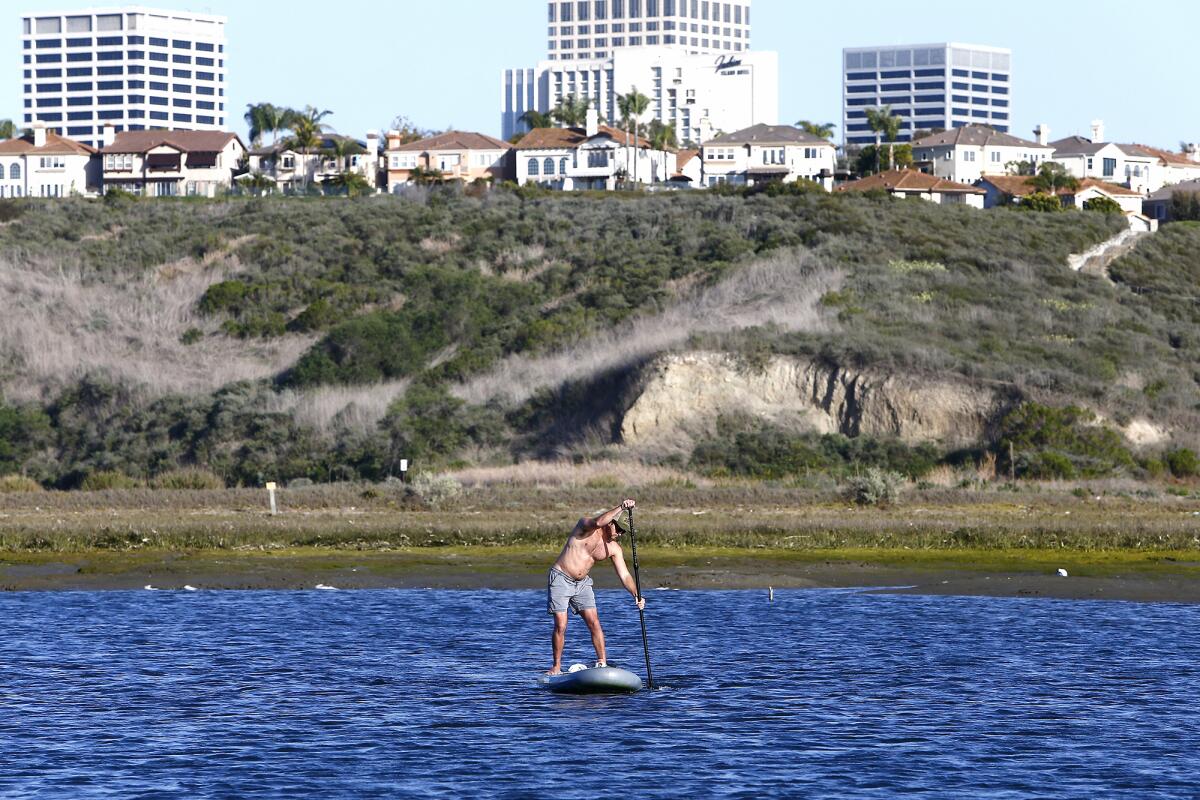New plan to reduce copper in Newport Bay approved by Santa Ana Regional Water Control Board

- Share via
The Santa Ana Regional Water Quality Control Board recently passed a plan to regulate the amount of copper in Newport Bay, but officials with the city of Newport Beach contend that the path forward to address the issue is murkier than it seems.
In 2002, the U.S. Environmental Protection Agency established thresholds of toxic substances for both Newport Bay and San Diego Creek, the latter being the primary tributary into the bay.
The total maximum daily loads — known as TMDLs — define the amount of a pollutant that can enter a body of water without resulting in violations of water quality standards set forth by the U.S. Clean Water Act. The TMDLs included copper, which the federal agency determined was impairing Newport Bay, and have been on the books for years, but there has never been an implementation plan formally put into place.
At high concentrations, copper is toxic to aquatic life. Staff with the Santa Ana Regional Water Quality Control Board noted in a report prepared for its December meeting that discharges from copper antifouling paints on boats are the most significant contributor of the mineral in the water.
As approved, the implementation plan will require continued monitoring of copper concentrations in Newport Bay and require responsible dischargers — the city of Newport Beach, the county of Orange and others — to develop plans and schedules to address the total maximum daily loads for copper.
Board staff identified a few compliance strategies such as the use of boat-cleaning best management practices (BMPs) and the conversion of paints. But city staff contend that implementing this plan won’t succeed.
“BMPs are things like public education, having hull cleaners do their job correctly, but from seeing our partners in the port of San Diego and Marina del Rey, we know these BMPs won’t get us into compliance,” senior civil engineer John Kappeler said in an interview Thursday.
Kappeler noted San Diego had implemented a number of these strategies but still wasn’t able to bring the copper content in the water down to what is defined in the EPA’s California Toxics Rule. Acute concentrations of copper are defined to be 4.8 parts per billion while chronic concentrations are at 3.1.
Kappeler contends the rates of copper in Newport Bay aren’t nearly as high as is suggested, though he acknowledged there are parts of the bay where concentrations are higher but do not reach toxic levels.
“The city of Newport Beach remains committed to improving water quality. Regarding copper, the BMPs our partners have implemented to date haven’t produced the results we’re all hoping for,” said Kappeler, adding that the city is partnered with the California Department of Pesticide Regulation to study the results of a law that went into effect in 2018 that established a maximum leach rate for copper paints.
“The California Department of Pesticide Regulation is currently implementing a new solution, and the city of Newport has and will continue to actively partner with them,” Kappeler said.
In addition, Kappeler noted Newport Harbor is not solely a recreational harbor and that while the city holds a certain amount of jurisdiction over its waterways, it does not have sway over the vessels that travel in and out of them.
“The challenge we have is the city of Newport Beach maintains the roads within the city of Newport Beach. We do not regulate the cars that drive up and down those roads. If there’s cars that don’t pass their smog checks, we have no regulatory authority,” said Kappeler. “We also maintain the waterways in Newport Harbor, but we have no legal authority to regulate the boats coming in and out of harbor.
“If boats were painted in Mexico, Oregon, how do we know that? How do we regulate that? We have no clue how to do that.”
What’s more is that the 2018 law is only applicable to recreational boats, not commercial boats.
Still, those at OC Coastkeeper argued taking the regulatory actions were still necessary in order to address water quality of Newport Bay, even as they acknowledged the limitations of some of the possible solutions.
“There’s this new formulation. [The city] wants to see if that works, but the problem is the scientists have already done the math. Using this low copper paint, ... you’re not going to make it. You’re still going to have to do something else,” said OC Coastkeeper associate director of programs Ray Hiemstra. “... There’s strategies to reduce the amount of boat cleaning, to do a better job of cleaning and then the most controversial ... is the use of non-copper bottom paints.”
Zinc-based paints are available but could lead to a similar issue with leaching experienced with copper paints. Slippery, non-biocide paints could potentially leach other chemicals into the water. There’s also the matter of high costs associated with making those conversions.
“There’s a variety of options that we know work. We’ve seen progress in San Diego. San Diego was supposed to meet their goal of their TMDL this year, but they’re not going to meet it. Still, they reduced it by 40%,” said Hiemstra. “That’s a big reduction and how they did that was by implementing the bottom-cleaner certification program, educating boaters on copper paint, encouraging as soon as possible to get that lower copper paint and if at all possible use another alternative.”
Hiemstra noted that the crux of the issue comes down to embedded behaviors between paint manufacturers, boatyards, maintenance crews and boat owners themselves.
“This is how [they] make their money. Why rock the boat? This seriously rocks the boat,” said Hiemstra. “... This is one of those things where this is just … requiring a lot of work that nobody wants to do. We don’t drive the same type of cars we did 20 years ago. Things need to evolve, and boat-bottom paint needs to evolve, and it’s been a slow and very painful process.”
The implementation plan will next go to the California State Water Resources Control Board for further review.
All the latest on Orange County from Orange County.
Get our free TimesOC newsletter.
You may occasionally receive promotional content from the Daily Pilot.




